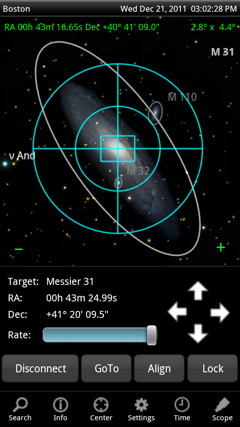Hosts:
Fraser Cain (universetoday.com / @fcain)
Dr. Kimberly Cartier (KimberlyCartier.org / @AstroKimCartier )
Dr. Morgan Rehnberg (MorganRehnberg.com / @MorganRehnberg & ChartYourWorld.org)
Dr. Brian Koberlein (briankoberlein.com / @BrianKoberlein)
Space-y Charity: Some Ideas To Respond To Astronaut Hadfield’s Challenge
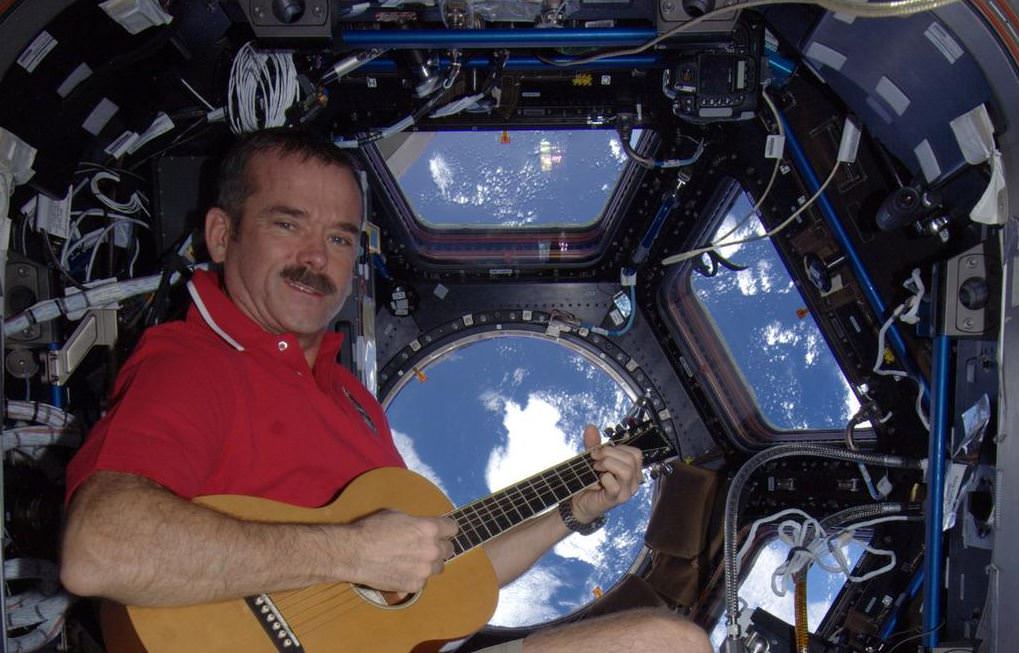
While the world was enchanted with Chris Hadfield’s social media posts last year, a new video has the retired astronaut talking about loftier things. Say, for example, how humanity landed a camera on the Saturn moon Titan back in 2005. Or to be more practical, the fact that smallpox was eradicated in its naturally occurring form.
In his talks and books, Hadfield describes himself as one who never focuses on complaining. He was almost yanked from his command of the International Space Station due to a medical issue, but he pressed on and convinced the doctors to let him fly. And in this new video, he focuses on what humans do generally to make the world better — imperfect as it is.
“There are problems with everything, and nothing’s perfect, but that shouldn’t be cause to moan. That should be cause to achieve. Our world is a better place than we often claim it to be,” Hadfield said. “We live the way we do,” he added, “because people chose to tackle their problems, head on.”
The video appears to have a heavy emphasis on the Bill & Melinda Gates Foundation, a gigantic philanthropic network that works to improve lives in the developing world and also for the disadvantaged in the United States. But there are many ways to give back to your community, even through gestures as simple as volunteering.
Here are some examples in the space world (note that these aren’t necessarily endorsements for the organizations, but just ideas for making contributions in space and astronomy):
- Cosmoquest, which runs online astronomy courses and also allows citizens to map extraterrestrial bodies right alongside astronomers.
- Astronomers Without Borders brings astronomy education across the world, particularly to developing countries.
- Uwingu says that half of its donations goes to grants to support learning in astronomy.
Other examples of space-y charity could include volunteering or donating to a local school or university, joining one of the numerous volunteer organizations in astronomy, or getting involved in a space advocacy group.
Help Bring Astronomy to Children in East Africa
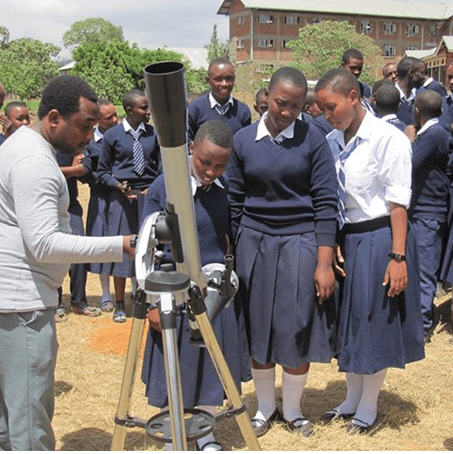
The international astronomy outreach group Astronomers Without Borders has launched a major crowdfunding campaign on Indiegogo, and they need your help. They are looking to raise $38,000 to fund a science center and observatory in East Africa to bring quality science education to the children of the area.
“It will be a game-changer for the region and a big project demonstrating the importance of astronomy education, including new curricula for teaching astronomy, teacher training, and more,” Mike Simmons, President and founder of AWB told Universe Today.
AWB has been actively working in this region since 2011 with their Telescopes to Tanzania project.
Simmons said Tanzanian students are often without textbooks and many basic educational resources and teacher training in science is often lacking.
“Providing the opportunity for people to get involved in this important project in East Africa is a perfect fit for Astronomers Without Borders’ motto, ‘One People, One Sky,'” he said.
After three years of making a difference in Tanzania by providing telescopes and teacher resources for schools, this new campaign goes even further, helping to provide a sustainable vision for the future and a pathway to success for the country’s youth.
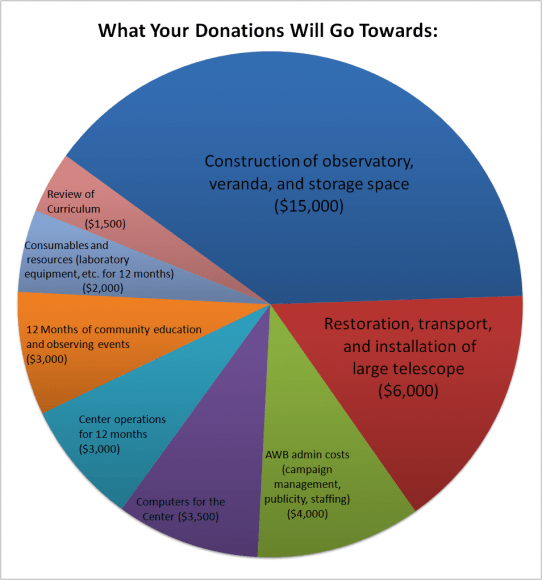
The Center for Science Education and Observatory will provide astronomical and science training for both teachers and students. AWB said in a press release that by integrating astronomy into the national teaching curriculum, the center will be able to develop and circulate hands-on science and astronomy teaching resources to schools around the country. The center will also house hands-on laboratories, and an astronomical observatory with a portable planetarium, and internet connectivity so that connections can be made with science centers worldwide.
“We’re excited to be taking the next step in making this unique and innovative project a sustainable reality,” said Simmons. “The need is great and a lot has already been accomplished.”
To learn more about supporting The Center for Science Education and Observatory and Telescopes to Tanzania visit the Indiegogo campaign page at
Help Schoolkids in Africa Participate in November 2013 Eclipse

Astronomers Without Borders – those great folks who do science outreach around the world – is getting ready for the next solar eclipse, which takes place on November 3, 2013. A partial eclipse will be visible across a wide swath of Africa and AWB needs your help so that tens of thousands of eclipse glasses can be sent to schools in Africa in time for the eclipse.
“We’re working with the IAU’s Office of Astronomy for Development who has contacts working with schools and able to distribute the glasses to them,” Mike Simmons, who leads AWB, told Universe Today via email. “The opportunity for this came up late so we’re working very hard to make it happen in the short time we have left.”
Simmons added that this is a rare opportunity to expose students to science in a region where science resources are often non-existent, and AWB will be giving the glasses to schools at no charge.
But they need donations to make that happen. Click here to find out how to help.
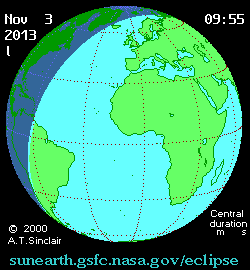
The AWB website says that schools have been identified and vetted by partner organizations in each country in Africa, and distribution networks have been verified. Every donated pair of eclipse glasses WILL reach a student for use for the eclipse. The International Astronomical Union’s Office of Astronomy for Development, which is based in Cape Town, South Africa, is providing invaluable support and assistance through their many contacts across Africa.
This program depends entirely on donations.
“There’s no question we can get all the donations that are needed as long as we get the word out in time,” Simmons said.
Please consider donating, as AWB does amazing work.
“We do probably a half-million dollars in programs each year based on the hard work of passionate amateur astronomers and educators around the world,” Simmons said, “all on way less than $25,000 a year.”
This is a great astronomy outreach organization that really could use financial help of any kind, so feel free to donate to their general cause, as well.
You can also purchase eclipse glasses for your own use from AWB here.
Get Great Astronomy Apps and Support Astronomers Without Borders
[/caption]
Celebrate the last two weeks of Global Astronomy Month and get a great price on the very popular SkySafari 3 apps for Apple and Android mobile devices and Mac OS X. Not only will you get an app that has been called a ‘game-changer’ for astronomy software, but during a special promotion, 30% of proceeds from all SkySafari sales will be donated to Astronomers Without Borders to support their wonderful programs.
All three versions of SkySafari 3 — Basic, Plus and Pro – are now at significant discounts, and if you’ve been considering purchasing SkySafari, now is the time, especially since you can support the great work of Astronomers Without Borders at the same time.
SkySafari 3 – $1.99 (regularly $2.99). 120,000 stars and 220 star clusters, nebulae, and galaxies. Solar system’s major planets and moons using NASA spacecraft imagery, 20 asteroids and comets.
SkySafari 3 Plus – $11.99 (regularly $14.99). Wired or wireless telescope control with accessories sold separately. 2.5 million stars, 31,000 deep sky objects (with entire NGC/IC catalog), over 4,000 asteroids, comets, and satellites.
SkySafari 3 Pro – $39.99 (regularly $59.99). Wired or wireless telescope control with accessories sold separately. 15 million stars (most of any astronomy app), 740,000 galaxies to 18th magnitude, over 550,000 solar system objects including every known comet and asteroid.
If you don’t need the SkySafari app, please consider donating to AWB.
Mike Simmons, who leads AWB, told Universe Today that this astronomy outreach organization really could use financial help.
“We do probably a half-million dollars in programs each year based on the hard work of passionate amateur astronomers and educators around the world,” he said, all on way less than $25,000 a year.
“This can’t be sustained, of course, and our programs — and everyone’s expectations of us — continue to grow,” Simmons wrote. “This is really, really important to us. 2012 presents many opportunities and we’re working on them. But we need to convert some of the passion we have in abundance to income to keep it going. If we can’t do it this year then I’m not sure we can do it in the future.”
Another way to help AWB is to purchase special eclipse glasses for the upcoming eclipse and the Venus transit – for which AWB has big plans for helping people around the world observe this very infrequent event.
Also, there is the a program allowing people to buy a quality small refractor and have a second one donated to a club or school in a developing country.
For more information, check out Astronomers Without Borders and the SkySafari 3 app sale, the eclipse glasses and the BOGO for a small refractor telescope for you and a needy school.
Thanks in advance for your support of a great organization!
Help Astronomers Measure the Solar System!
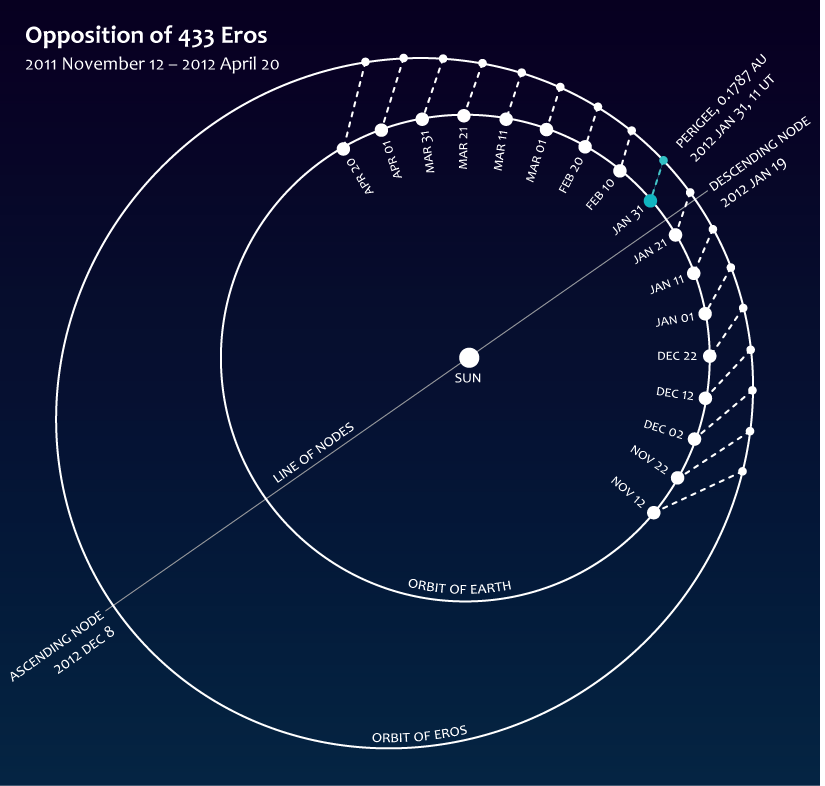
[/caption]
As the bright Mars-crossing asteroid 433 Eros makes its closest approach to Earth since 1975, astronomers around the globe are taking the opportunity to measure its position in the sky, thereby fine-tuning our working knowledge of distances in the solar system. Using the optical principle of parallax, whereby different viewpoints of the same object show slightly shifted positions relative to background objects, skywatchers in different parts of the world can observe Eros over the next few nights and share their images online.
The endeavor is called the Eros Parallax Project, and you can participate too!
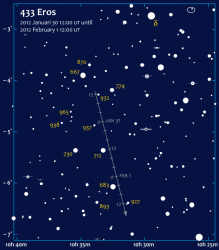
Discovered in 1898, Eros was the largest near-Earth asteroid yet identified. Its close and relatively bright oppositions were calculated by astronomers of the day and used, along with solar transits by Venus (one of which, if you haven’t heard, will also occur this year on June 5!) to calculate distances in the inner solar system.
Having both events take place within the same year offers today’s astronomers an unparalleled opportunity to obtain observational measurements.
Through the efforts of the Astronomers Without Borders organization, along with Steven van Roode and Michael Richmond from the Transit of Venus project, anyone with moderate astrophotography experience can participate in the observation of Eros and share their photos via free online software.
Using the data gathered by individual participants positioned around the world, each with their own specific viewpoints, astronomers will be able to precisely measure the distance to Eros.
The more accurately that distance is known, the more accurately the distance from Earth to the Sun can be calculated – via the orbital mechanics of Kepler’s third law.

The last time such a bright pass of Eros occurred was in January of 1931. Observations of the asteroid made at that time allowed astronomers to calculate a solar parallax of 8″ .790, the most accurate up to that time and the most accurate until 1968, when data acquired by radar measurements gave more detailed measurements.
In many ways the 2012 close approach by Eros – astronomically close, but still a very safe 16.6 million miles (26.7 million km) away – will allow for a re-eneactment of the 1931 event… with the exception that this time amateur skywatchers will also contribute data, instantly, from all over the world!
One has to wonder…when Eros comes this close again in 2056, what sort of technology will we use to watch it then…
Find out more about the Eros Parallax Project and how to participate here.
And be sure to check out the article about the project on Astronomers Without Borders as well.
Popular Astronomy App Supports Astronomers Without Borders
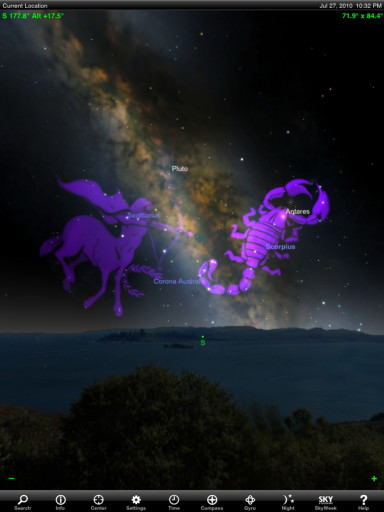

You can support a great organization, Astronomers Without Borders, by purchasing a popular astronomy app for Apple and Mac devices. SkySafari 3 is a “revolutionary” app that can completely cover your observing/educational needs. During a special promotion that is available until December 8, 40% of proceeds from all SkySafari sales will be donated to Astronomers Without Borders to support their global programs. Some significant discounts are also being offered, so you can get a great price and help build AWB’s worldwide astronomy community at the same time.
You’ve probably heard of some of AWB’s project, such as The World at Night, Global Astronomy Month, and 100 Hours of Astronomy. AWB nobly works to foster understanding and goodwill across national and cultural boundaries by creating relationships through the universal appeal of astronomy. They provide and share resources, information and inspiration.
With all the great work they are doing, AWB needs some help to continue their outreach. “Interest and demand have really outstripped our start-up, volunteer, grass-roots organization,” AWB President Mike Simmons told Universe Today. “So we’re starting a fund-raising campaign that we hope will get us over the hump so we can keep up with all the opportunities there are.”
If you are considering getting an astronomy app for yourself or someone else for the holidays, consider SkySafari 3, the latest version of this popular app – and you can support AWB at the same time. But hurry – this offer ends on Dec. 8, 2011.
You can also support AWB even if you don’t need an app.
More info:
Continue reading “Popular Astronomy App Supports Astronomers Without Borders”

